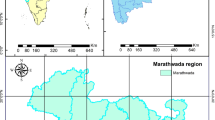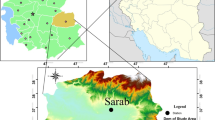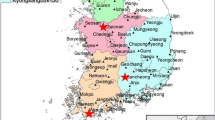Abstract
Long-range (1 to 6 months in advance) prediction of droughts is challenging due to its inherent complexity. In this study, we developed a Long-Range Hydrological Drought Prediction Framework (HDPF), empowered by a Deep Learning (DL) approach. Starting with two state-of-the-art approaches, namely Long Short-Term Memory (LSTM), and one-dimensional Convolutional neural networks (Conv1D), we picked out Conv1D to develop the HDPF, being its relatively better performance. The devised HDPF leverages a comprehensive set of eight meteorological precursors, harnessing their collective potential to offer predictions of reasonable accuracy (> 70%). The developed HDPF is able to extract the hidden information from the pool of meteorological precursors along with its evolution over time and influence on the upcoming drought status. Additionally, while comparing the performance of the Conv1D against LSTM, it is noticed that the performance of LSTM is at par with that of Conv1D. However, considering the model parsimony and computational time we advocate the usage of Conv1D. Moreover, comparison against other popular machine learning models, such as Support Vector Regression (SVR) and Feedforward Neural Network (FNN) further affirms the superiority as well as benefits of Conv1D. The developed HDPF can also be useful to other basins in a different climate regime, subject to its recalibration with the location-specific datasets. Overall, this study advances drought prediction methodologies by demonstrating the potential of DL techniques while underscoring the utility and adaptability of the proposed Conv1D-based HDPF.




Similar content being viewed by others
Data Availability
The data that support the findings of this study are available from: https://www.ecmwf.int/en/forecasts/datasets/reanalysis-datasets/era5, and https://indiawris.gov.in/wris/#/RiverMonitoring. The datasets are freely available and was accessed by the authors in November 2022.
Code Availability
The codes required for the analysis are written in python using scientific python development environment (spyder) IDE. The codes may be available on request from the authors.
References
AghaKouchak A, Farahmand A, Melton FS et al (2015) Remote sensing of drought: Progress, challenges and opportunities. Rev Geophys 53:452–480. https://doi.org/10.1002/2014RG000456
Akbari H, Rakhshandehroo GR, Sharifloo AH, Ostadzadeh E (2015) Drought analysis based on standardized precipitation index (SPI) and streamflow drought index (SDI) in Chenar Rahdar River Basin, Southern Iran. Proc Watershed Manag Symp Am Soc Civ Eng 11–22. https://doi.org/10.1061/9780784479322.002
Anshuka A, van Ogtrop FF, Willem Vervoort R (2019) Drought forecasting through statistical models using standardised precipitation index: a systematic review and meta-regression analysis. Nat Hazards 97:955–977. https://doi.org/10.1007/s11069-019-03665-6
ASCE Task Committee (2000) Artificial neural networks in hydrology. I: Preliminary concepts. J Hydrol Eng 5:115–123
Asokan SM, Dutta D (2008) Analysis of water resources in the Mahanadi River Basin, India under projected climate conditions. Hydrol Process 22:3589–3603. https://doi.org/10.1002/hyp
Chai T, Draxler RR (2014) Root mean square error (RMSE) or mean absolute error (MAE)? -Arguments against avoiding RMSE in the literature. Geosci Model Dev 7:1247–1250. https://doi.org/10.5194/gmd-7-1247-2014
Chanda K, Maity R (2015) Meteorological drought quantification with standardized precipitation anomaly index for the regions with strongly seasonal and periodic precipitation. J Hydrol Eng 20:06015007. https://doi.org/10.1061/(asce)he.1943-5584.0001236
Crausbay SD, Ramirez AR, Carter SL et al (2017) Defining ecological drought for the twenty-first century. Bull Am Meteorol Soc 98:2543–2550. https://doi.org/10.1175/BAMS-D-16-0292.1
Deo RC, Kisi O, Singh VP (2017) Drought forecasting in eastern Australia using multivariate adaptive regression spline, least square support vector machine and M5Tree model. Atmos Res 184:149–175. https://doi.org/10.1016/j.atmosres.2016.10.004
Dikshit A, Pradhan B, Assiri ME et al (2022a) Solving transparency in drought forecasting using attention models. Sci Total Environ 837:155856. https://doi.org/10.1016/j.scitotenv.2022.155856
Dikshit A, Pradhan B, Santosh M (2022b) Artificial neural networks in drought prediction in the 21st century–A scientometric analysis. Appl Soft Comput 114:108080. https://doi.org/10.1016/j.asoc.2021.108080
Duan S, Ullrich P, Shu L (2020) Using convolutional neural networks for streamflow projection in California. Front Water 2:1–19. https://doi.org/10.3389/frwa.2020.00028
Dutta R, Maity R (2021) Time-varying network-based approach for capturing hydrological extremes under climate change with application on drought. J Hydrol 603:126958. https://doi.org/10.1016/j.jhydrol.2021.126958
Fung KF, Huang YF, Koo CH, Soh YW (2020) Drought forecasting: A review of modelling approaches 2007–2017. J Water Clim Chang 11:771–799. https://doi.org/10.2166/wcc.2019.236
Gupta HV, Kling H, Yilmaz KK, Martinez GF (2009) Decomposition of the mean squared error and NSE performance criteria: Implications for improving hydrological modelling. J Hydrol 377:80–91. https://doi.org/10.1016/j.jhydrol.2009.08.003
Ham Y, Kim J, Luo J et al (2019) Deep learning for multi-year ENSO forecasts. Nature 573:567–572. https://doi.org/10.1038/s41586-019-1559-7
Hao Z, Singh VP, Xia Y (2018) Seasonal drought prediction: Advances, challenges, and future prospects. Rev Geophys 56:108–141. https://doi.org/10.1002/2016RG000549
Jariwala KA, Agnihotri PG (2023) Comparative analysis of drought modeling and forecasting using soft computing techniques. Water Resour Manag. https://doi.org/10.1007/s11269-023-03642-6
Khan MI, Maity R (2020) Hybrid deep learning approach for multi-step-ahead daily rainfall prediction using GCM simulations. IEEE Access 8:52774–52784. https://doi.org/10.1109/ACCESS.2020.2980977
Khan MI, Maity R (2022) Hybrid deep learning approach for multi-step-ahead prediction for daily maximum temperature and heatwaves. Theor Appl Climatol 149:945–963 (2022). https://doi.org/10.1007/s00704-022-04103-7
Kiranyaz S, Avci O, Abdeljaber O, et al (2021) 1D convolutional neural networks and applications: A survey. Mech Syst Signal Process 151:1–21. https://doi.org/10.1016/j.ymssp.2020.107398
Kratzert F, Klotz D, Herrnegger M et al (2019a) Toward improved predictions in ungauged basins: Exploiting the power of machine learning. Water Resour Res 55:11344–11354. https://doi.org/10.1029/2019WR026065
Kratzert F, Klotz D, Shalev G et al (2019b) Towards learning universal, regional, and local hydrological behaviors via machine learning applied to large-sample datasets. Hydrol Earth Syst Sci 23:5089–5110. https://doi.org/10.5194/hess-23-5089-2019
Latif SD, Ahmed AN (2023) Streamflow prediction utilising deep learning and machine learning algorithms for sustainable water supply management. Water Resour Manag 37:3227–3241. https://doi.org/10.1007/s11269-023-03499-9
Lees T, Reece S, Kratzert F et al (2022) Hydrological concept formation inside long short-term memory (LSTM) networks. Hydrol Earth Syst Sci 26:3079–3101. https://doi.org/10.5194/hess-26-3079-2022
Maity R, Khan MI, Sarkar S et al (2021) Potential of deep learning in drought assessment by extracting information from hydrometeorological precursors. J Water Clim Chang. https://doi.org/10.2166/wcc.2021.062
Makokha GO, Wang L, Zhou J et al (2016) Quantitative drought monitoring in a typical cold river basin over Tibetan Plateau: An integration of meteorological, agricultural and hydrological droughts. J Hydrol 543:782–795. https://doi.org/10.1016/j.jhydrol.2016.10.050
Mishra AK, Singh VP (2010) A review of drought concepts. J Hydrol 391:202–216. https://doi.org/10.1016/j.jhydrol.2010.07.012
Pearson K (1895) Mathematical contributions to the theory of evolution-III. Regression, heredity, and panmixia. Philos Trans R Soc A Math Phys Eng Sci 187:253–318. https://doi.org/10.1098/rsta.1896.0007
Pham QB, Yang TC, Kuo CM et al (2021) Coupling singular spectrum analysis with least square support vector machine to improve accuracy of SPI drought forecasting. Water Resour Manag 35:847–868. https://doi.org/10.1007/s11269-020-02746-7
Piri J, Abdolahipour M, Keshtegar B (2023) Advanced machine learning model for prediction of drought indices using hybrid SVR-RSM. Water Resour Manag 37:683–712. https://doi.org/10.1007/s11269-022-03395-8
Poonia V, Goyal MK, Gupta BB et al (2021) Drought occurrence in different river basins of India and blockchain technology based framework for disaster management. J Clean Prod 312:127737. https://doi.org/10.1016/j.jclepro.2021.127737
Rehana S, Monish NT (2020) Characterization of regional drought over water and energy limited zones of india using potential and actual evapotranspiration. Earth Sp Sci 7:e2020EA001264. https://doi.org/10.1029/2020EA001264
Reichstein M, Camps-Valls G, Stevens B et al (2019) Deep learning and process understanding for data-driven Earth system science. Nature 566:195–204. https://doi.org/10.1038/s41586-019-0912-1
Roushangar K, Ghasempour R, Alizadeh F (2022) Uncertainty assessment of the integrated hybrid data processing techniques for short to long term drought forecasting in different climate regions. Water Resour Manag 36:273–296. https://doi.org/10.1007/s11269-021-03027-7
Srivastava N, Hinton G, Krizhevsky A et al (2014) Dropout: a simple way to prevent neural networks from overfitting. J Mach Learn Res 15:1929–1958. https://doi.org/10.1109/ICAEES.2016.7888100
Willmott CJ, Robeson SM, Matsuura K (2012) A refined index of model performance. Int J Climatol 32:2088–2094. https://doi.org/10.1002/joc.2419
Acknowledgements
This study is supported by a sponsored project supported by Ministry of Earth Science (MoES), Government of India (Grant no. MoES/PAMC/H&C/124/2019-PC-II). Authors further acknowledge the National Supercomputing Mission (NSM) for providing computing resources of ‘PARAM Shakti’ at IIT Kharagpur, which is implemented by C-DAC and supported by the Ministry of Electronics and Information Technology (MeitY).
Funding
Ministry of Earth Science (MoES), Government of India, Grant no. MoES/PAMC/H & C/124/2019-PC-II, Rajib Maity.
Author information
Authors and Affiliations
Contributions
Conceptualization: Rajib Maity; Methodology: Mohd Imran Khan, Rajib Maity; Formal analysis: Mohd Imran Khan, Investigation: Mohd Imran Khan, Rajib Maity; Writing—original draft preparation: Mohd Imran Khan; Writing—review and editing: Rajib Maity; Funding acquisition: Rajib Maity; Resources: Rajib Maity; Supervision: Rajib Maity.
Corresponding author
Ethics declarations
Conflicts of Interest/Competing Interests
The authors have no relevant financial or non-financial interests to disclose.
Additional information
Publisher's Note
Springer Nature remains neutral with regard to jurisdictional claims in published maps and institutional affiliations.
Supplementary Information
Below is the link to the electronic supplementary material.
Rights and permissions
Springer Nature or its licensor (e.g. a society or other partner) holds exclusive rights to this article under a publishing agreement with the author(s) or other rightsholder(s); author self-archiving of the accepted manuscript version of this article is solely governed by the terms of such publishing agreement and applicable law.
About this article
Cite this article
Khan, M.I., Maity, R. Development of a Long-Range Hydrological Drought Prediction Framework Using Deep Learning. Water Resour Manage 38, 1497–1509 (2024). https://doi.org/10.1007/s11269-024-03735-w
Received:
Accepted:
Published:
Issue Date:
DOI: https://doi.org/10.1007/s11269-024-03735-w




